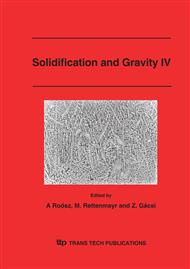p.573
p.579
p.585
p.591
p.597
p.603
p.609
p.615
p.621
Thermo-Mechanical Analysis of Directional Crystallisation of Multi-Crystalline Silicon Ingots
Abstract:
Multi-crystalline silicon ingot casting using directional crystallisation is the most costeffective technique for the production of Si for the photovoltaic industry. Non-uniform cooling conditions and a non-planarity of the solidification front result, however, in the build-up of stresses and viscoplastic deformation. Known defects, such as dislocations and residual stresses, can then occur and reduce the quality of the produced material. Numerical simulation, combined with experimental investigation, is therefore a key tool for understanding the crystallisation process, and optimizing it. The purpose of the present work is to present an experimental furnace for directional crystallisation of silicon, and its analysis by means of numerical simulation. The complete casting procedure, i.e., including both the crystallisation phase and the subsequent ingot cooling, is simulated. The thermal field has been computed by a CFD tool, taking into account important phenomena such as radiation and convection in the melt. The transient thermal field is used as input for a thermo-elasto-viscoplastic model for the analysis of stress build-up and viscoplastic deformation during the process. Numerical analysis is employed to identify process phases where further optimisation is needed in order to reduce generated defects.
Info:
Periodical:
Pages:
597-602
Citation:
Online since:
March 2006
Authors:
Keywords:
Price:
Сopyright:
© 2006 Trans Tech Publications Ltd. All Rights Reserved
Share:
Citation:


